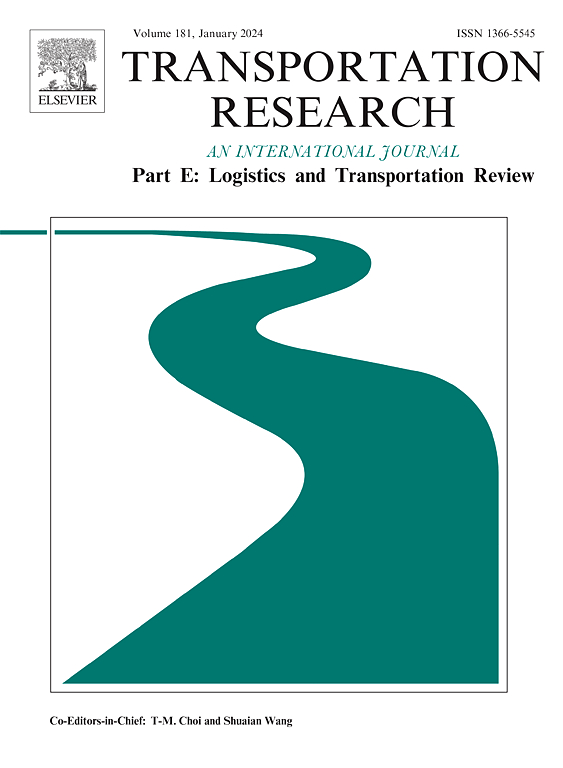基于飞行轨迹估算飞机燃油消耗的综合框架
IF 8.8
1区 工程技术
Q1 ECONOMICS
Transportation Research Part E-Logistics and Transportation Review
Pub Date : 2025-08-06
DOI:10.1016/j.tre.2025.104339
引用次数: 0
摘要
飞机燃油消耗量的计算对于航空公司的运营管理、环境保护等方面至关重要。使用广播自动相关监视(ADS-B)数据可以显著提高飞行路线上燃油消耗计算的准确性和分辨率。然而,ADS-B数据存在几个问题,包括不一致的数据点分布、不均匀的间隔宽度和飞行持续时间的可变性,这使得很难与燃油消耗数据保持一致。本研究建立了全面的数学框架,建立了ADS-B数据中的飞行动力学与燃油消耗之间的联系,提供了一套高精度、高分辨率的燃油计算方法。它还允许其他从业者通过该框架根据特定需求选择数据源。该框架包括三个主要步骤:(1)利用ADS-B数据确定飞行廓线,识别飞机的加速、减速、爬升和下降等行为,并建立它们与燃油消耗的理论关系和参数。(2)利用可获得的区间油耗数据拟合飞行剖面与油耗关系系数。(3)通过单调平滑插值计算瞬时油耗。我们对2022年4月至2023年12月ADS-B和飞机通信寻址和报告系统(ACARS)数据集进行了综合分析,重点关注中国11种最常见飞机类型的间隔和瞬时燃油消耗模式。间隔油耗误差在误差分布的第10个百分位数处降至0.1%,同时保持平均误差3.31%。即使在第90个百分位,误差仍然低于10%,这表明该模型在大多数情况下都具有稳健性。在瞬时油耗模型性能方面,波音737 MAX 800在巡航阶段的累积瞬时油耗误差仅为6.6%,而空客A321-200在爬升阶段的误差为7.1%,在下降阶段的误差为8.4%。本文章由计算机程序翻译,如有差异,请以英文原文为准。
A comprehensive framework for estimating aircraft fuel consumption based on flight trajectories
The calculation of aircraft fuel consumption is crucial for airline operations management, environmental protection, and other aspects. The use of Automatic Dependent Surveillance-Broadcast (ADS-B) data can significantly enhance the accuracy and resolution of fuel consumption calculations over flight routes. However, ADS-B data exhibits several issues, including inconsistent data point distribution, uneven interval widths, and variability in flight durations, making it difficult to align with fuel consumption data. This study developed a comprehensive mathematical framework and established a connection between flight dynamics in ADS-B data and fuel consumption, providing a set of high-precision, high-resolution fuel calculation methods. It also allows other practitioners to select data sources according to specific needs through this framework. The framework includes three main steps: (1) Using ADS-B data to determine the flight profile, which involves identifying aircraft behaviors such as acceleration, deceleration, climb, and descent, and establishing their theoretical relationships and parameters with fuel consumption. (2) Fitting the coefficients of the relationship between flight profiles and fuel consumption using available interval fuel consumption data. (3) Calculating instantaneous fuel consumption through monotonic and smooth interpolation. Our comprehensive analysis of ADS-B and Aircraft Communications Addressing and Reporting System (ACARS) datasets from April 2022 to December 2023, focusing on interval and instantaneous fuel consumption patterns among China’s 11 most prevalent aircraft types. The interval fuel consumption error demonstrates a reduction to 0.1% at the 10th percentile of the error distribution, while maintaining a mean error of 3.31%. Even at the 90th percentile, the error remains below 10%, demonstrating the model’s robustness across most scenarios. Regarding instantaneous fuel consumption model performance, the Boeing 737 MAX 800 demonstrates a cumulative instantaneous fuel consumption error of just 6.6% during cruise phase, while the Airbus A321-200 shows errors of 7.1% during climb and 8.4% during descent phases.
求助全文
通过发布文献求助,成功后即可免费获取论文全文。
去求助
来源期刊
CiteScore
16.20
自引率
16.00%
发文量
285
审稿时长
62 days
期刊介绍:
Transportation Research Part E: Logistics and Transportation Review is a reputable journal that publishes high-quality articles covering a wide range of topics in the field of logistics and transportation research. The journal welcomes submissions on various subjects, including transport economics, transport infrastructure and investment appraisal, evaluation of public policies related to transportation, empirical and analytical studies of logistics management practices and performance, logistics and operations models, and logistics and supply chain management.
Part E aims to provide informative and well-researched articles that contribute to the understanding and advancement of the field. The content of the journal is complementary to other prestigious journals in transportation research, such as Transportation Research Part A: Policy and Practice, Part B: Methodological, Part C: Emerging Technologies, Part D: Transport and Environment, and Part F: Traffic Psychology and Behaviour. Together, these journals form a comprehensive and cohesive reference for current research in transportation science.

 求助内容:
求助内容: 应助结果提醒方式:
应助结果提醒方式:


